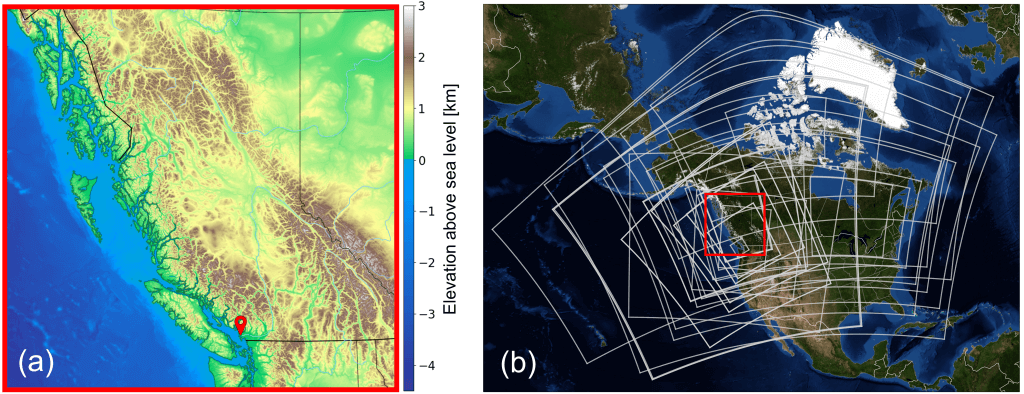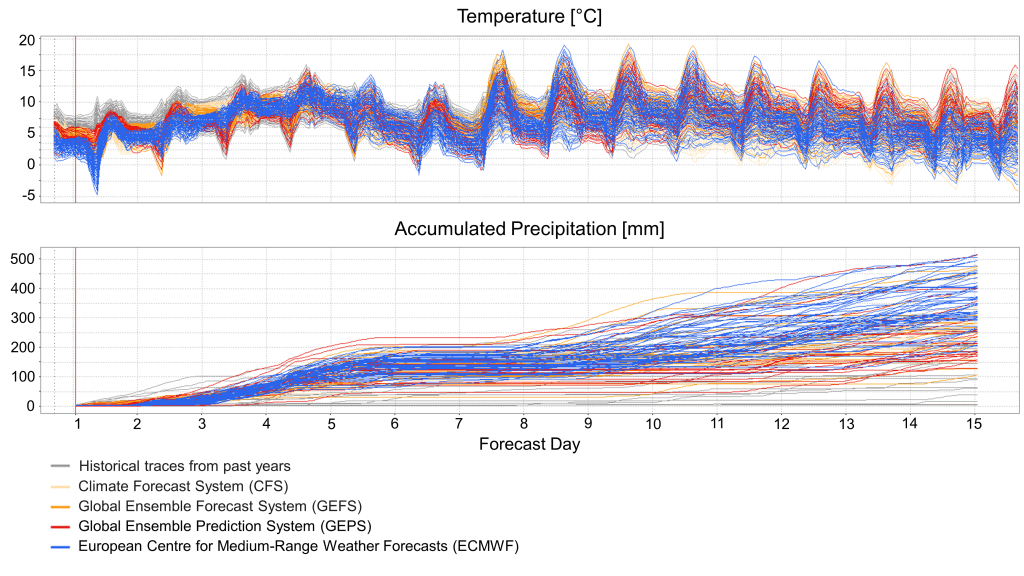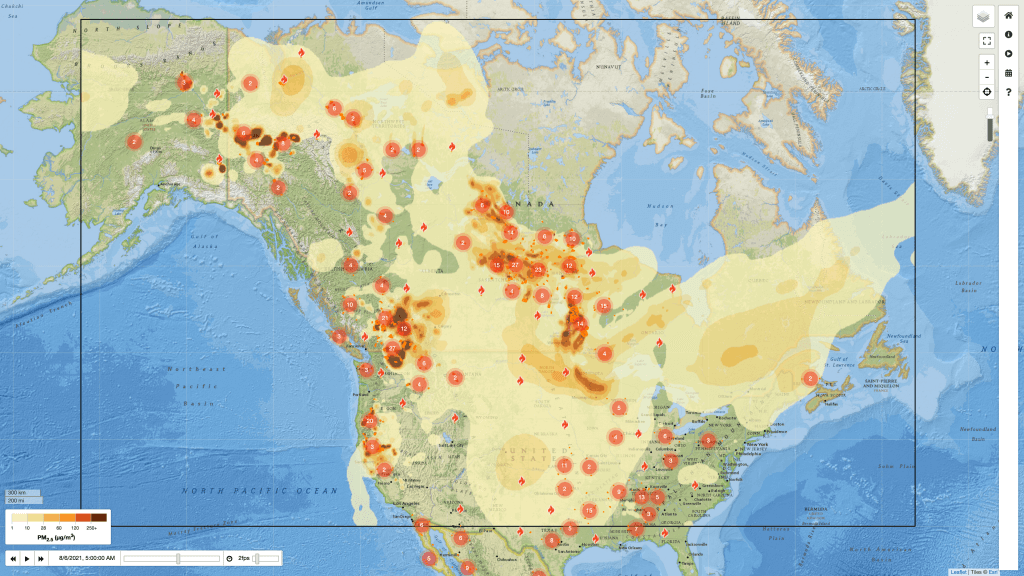
The Weather Forecast Research Team: A Nexus of Operational Weather Forecasting and Research in Western Canada
– By Julia Jeworrek, Dr. Rosie Howard and Prof. Roland B. Stull –
Foundations
In 1995, the Weather Forecast Research Team (WFRT) [1] was formed by Prof. Roland Stull at UBC with four Ph.D. students. Living in the complex mountainous and coastal terrain of British Columbia (BC; Fig. 1a), Prof. Stull witnessed the challenges involved in making accurate forecasts for western Canada. As a result, he expanded his focus from atmospheric boundary layers to numerical weather prediction (NWP), with the ultimate goal of improving forecasts for western Canada.
The WFRT began making daily operational forecasts using a small ensemble of two NWP models in 1996. As the team grew, so did the ensemble size and range of research projects, drawing the interest of external collaborators and clients. By combining research with operational weather forecast services for the last 25 years, the WFRT has become one of the largest ensemble weather-forecast providers in Canada outside of Environment and Climate Change Canada (ECCC).
Today, the WFRT consists of over 20 people including senior academics, graduate and undergraduate students, IT staff and technicians, adjunct professors, and visiting scientists. This international team brings together people from diverse academic and cultural backgrounds; the resulting exchange of ideas and expertise is key to their scientific innovation.
The team’s operational NWP ensemble suite includes initial and boundary conditions from six global or continental models [2], fed into four NWP models [3] with various grid lengths, domain sizes (Fig. 1b), forecast horizons, and physics parameterizations. Their largest ensemble of 48 members is run using initialization fields from 00 UTC, and reduced-member ensembles are initialized at 06, 12, and 18 UTC. To provide the best accuracy and optimal utility, these deterministic weather forecasts are post-processed in several different ways; downscaled to weather stations and forecast locations of interest, statistically bias-corrected, and combined into calibrated probabilistic ensemble forecasts, to name a few. These post-processing components are key to combating the challenges presented by complex terrain and the relative lack of upstream data over the Pacific Ocean. An automated real-time verification tool is currently being developed for quality control and to facilitate further relevant research.

To accommodate the vast number of operational model runs, data-processing routines, and research needs, the WFRT employs high-performance computing resources including their own 552-core Linux cluster, the Google Cloud Platform, and Compute Canada allocations, as well as dozens of auxiliary servers for post-processing and data storage. A multitude of forecast products (e.g., animated maps, graphs, text files) are prepared to serve the unique requirements of our clients in a timely manner. The synergy between (a) their forecasting services for external clients, which provides funding to keep the non-profit team operating, and (b) their cutting-edge research, which continuously improves forecast quality, mutually benefits enhancements in scientific and economic applications.
Throughout the years, the team’s research has sprouted many branches and attracted a wide range of clients. The following sections cover two of their primary research and development themes.
Clean Energy
Close collaboration with BC’s primary electric utility, BC Hydro, began in 1997 and has sparked diverse research projects in support of clean energy. This long-standing partnership ultimately aims to improve the safety, reliability, and economic productivity of electric power operations. Also, in the face of the current climate crisis, clean-energy efficiency continues to be an area of growing significance. Over the years, the WFRT has built and maintained a customized suite of NWP products that are reliable, innovative, cost-effective, and state-of-the-art. Regular communication ensures that the WFRT can target new requests effectively and attend to technical issues promptly.
BC Hydro requires daily hydrometeorological forecasts for their reservoir operations and planning. WFRT products include hourly and daily, deterministic and probabilistic, bias-corrected point and gridded forecasts of precipitation and temperature. One example is a 15-day “superensemble” consisting of 167 individually post-processed weather forecasts, spanning a large range of possible atmospheric scenarios (Fig. 2). The resulting probabilistic forecasts assist BC Hydro in their everyday decision-making based on their risk tolerance for certain events.

Various active research projects are being conducted to further enhance the hydrometeorological forecasts:
- Comprehensive precipitation evaluation studies of systematically varied NWP physics parameterizations over one year and for certain meteorological cases are helping to identify strengths and flaws among different model setups. The team is also investigating whether verification using ground-based dual-polarization radar observations can inform improvements of hydrometeor representation in microphysics parameterizations.
- Extreme rainfall events are often challenging to forecast and statistical and machine learning (ML) post-processing methods improve accuracy. One of the WFRT advances is a new technique that combines analog ensembles, Schaake shuffle, and convolutional neural networks.
- Since run-of-river hydroelectric power output depends on stream inflow, a current study is developing an ensemble of streamflow forecasts.
Although hydroelectricity contributes by far the most (~ 91%) to BC’s total electricity generation capacity, wind power also provides a small (~ 4%) but important proportion. The WFRT produces hourly probabilistic 7-day wind speed forecasts each day for 18 wind farms in BC and the Columbia River Gorge. Where available, wind-speed observations are used for bias correction. Wind forecast performance is verified using various metrics on a weekly and seasonal basis. Additionally, the WFRT produces wind power and energy production forecasts based on wind-farm power curves. The following projects exemplify efforts to continually improve these forecasts:
- Physics parameterizations that previously performed well for hub-height winds and precipitation forecasts also gave good results in recent windstorm case studies. This consensus among studies investigating different variables helps identify optimal model configurations for BC.
- A hybrid dynamical-statistical downscaling method is currently in development to derive wind forecasts on finer spatial scales, incorporating ML techniques.
- Another project attempts to enhance the local topography representation in a weather model.
- Artificial neural networks with NWP input were trained on observations from two wind-farms to predict wind power up to 7 days ahead.
Additional projects have targeted improvements in power grid operations (e.g., electric load predictions, forecasts for transmission lines), solar power forecasts (e.g., parameterizations for solar radiation based on cloud cover), and biomass energy operations (e.g., dispersion forecasts for odor alerts).
BlueSky-Canada: Fire Weather and Smoke Forecasting
Wildfires and smoke affect the safety of Canadian residents and tourists every year. To mitigate these issues, in 2007 the WFRT began researching and developing smoke forecasts with support from BC and Alberta provincial health agencies. Since 2010, the team has been running the BlueSky smoke modelling framework operationally, adapted for use in Canada, to produce ground-level smoke concentration forecasts every day (Fig. 3).
In recent years, several provinces have seen an increase in wildfire frequency and extent. Also, it is predicted that future forest-fire seasons in North America will bring increased levels of fire and smoke activity. To help determine potential fire behaviour across the country, fire-weather forecasts were added to the team’s portfolio in 2019.

BlueSky is a complex pipeline of models driven by inputs of (a) fire information such as satellite hotspots and ground reports, and (b) meteorology from one of the team’s NWP models. Using these, it calculates fire emissions, smoke plume rise, and dispersion, with updates every six hours. During the fire season (April–October), a website displays the output on animated maps (see user tutorials).
The modelling chain of the pipeline provides plenty of opportunities for improvement and further research:
- A new plume-rise parameterization for predicting smoke injection height was recently developed using large-eddy simulations for a wide range of wildfire and atmospheric scenarios. This is currently being implemented into BlueSky for comparison with the old scheme, which was designed for smoke chimney stacks, not wildfires.
- Estimating emissions relies on accurate fire growth predictions; BlueSky currently assumes linear growth with 3-day persistence. The WFRT is working on a new hybrid empirical-ML model to replace this simplistic approach.
- The team’s near-real-time quantitative verification system actively helps identify forecast issues. It is being further developed to include a column-integrated smoke product that can be validated fairly and qualitatively using satellite images.
- Wet deposition can remove smoke from the atmosphere during dispersion; case studies are currently being conducted to tune parameters that model this process with the goal of reducing the false alarm rate.
Outlook
The WRFT plans to move more of their research and operations to cloud computation services. They also continue exploring artificial-intelligence tools, while broadening their research towards regional climate projections. To read more about the UBC WFRT, including past and current projects, visit their website.
[1] The WFRT is a research facility of the Department of Earth, Ocean and Atmospheric Sciences (EOAS) at the University of British Columbia (UBC) in Vancouver, Canada.
[2] 0.25° and 0.5° Global Forecast System (GFS), 0.5° Navy Global Environmental Model (NAVGEM), 32-km North American Mesoscale Model (NAM), 15-km Global Deterministic Forecast System (GDPS), 0.5° Action de Recherche Petite Échelle Grande Échelle (ARPEGE), and 0.25° Icosahedral Nonhydrostatic model (ICON).
[3] Weather Research and Forecasting (WRF) model with Advanced Research WRF (ARW) and Nonhydrostatic Mesoscale Model (NMM) cores, Pennsylvania State University / National Center for Atmospheric Research mesoscale model (MM5), and the Model for Prediction Across Scales (MPAS).
Julia Jeworrek is a PhD Candidate in Atmospheric Sciences with the Department of Earth, Ocean and Atmospheric Sciences at UBC. Her research area is in precipitation predictability. She previously obtained a BSc in Meteorology in Germany and a MSc in Meteorology in Sweden.
Dr. Rosie Howard is a UBC Research Associate and WFRT Associate Director. Her current research focus is wildfire smoke modelling. She also keeps the team operating with her leadership and supervision across the board.
Prof. Roland B. Stull is a professor of atmospheric sciences at UBC. He is a fellow of both the Canadian Meteorological and Oceanographic Society (CMOS) and the American Meteorological Society (AMS), and winner of the Killam Teaching Prize.
BlueSky - Canada, Forecasting, Forest fires, UBC, Wind energy
